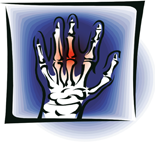 Arthritis is inflammation of one or more joints. Osteoarthritis is the commonest form of arthritis. It is also known as degenerative joint disease. According to the Arthritis Foundation, this chronic disease affects more than 27 million Americans. More than half the seniors over age 65 have evidence of osteoarthritis. Osteoarthritis occurs when the joint cartilage breaks down over time. It most commonly affects joints of the hands, hips, knees, lower back and neck.
Arthritis is inflammation of one or more joints. Osteoarthritis is the commonest form of arthritis. It is also known as degenerative joint disease. According to the Arthritis Foundation, this chronic disease affects more than 27 million Americans. More than half the seniors over age 65 have evidence of osteoarthritis. Osteoarthritis occurs when the joint cartilage breaks down over time. It most commonly affects joints of the hands, hips, knees, lower back and neck.
Risk factors for osteoarthritis
- Previous joint injuries
- Older age
- Female gender
- Bone deformities
- Occupations with repetitive stress on a particular joint
 Common symptoms of arthritis
Common symptoms of arthritis
- Joint pain
- Joint stiffness
- Swelling
- Loss of flexibility
- Grating sensation
How is osteoarthritis diagnosed?
X-ray imaging of affected joints may reveal narrowing of the joint space, which indicates that the cartilage is worn out. Bone spurs may be seen around the joint.
What lifestyle modifications are recommended?
Maintaining function and preventing disability is key to living well with arthritis. Exercise is important to preserve joint function and improve flexibility. Yoga and Tai Chi offer gentle exercises that help balance, posture and flexibility. Physical therapy is useful to strengthen the muscles around the joints and increase range of motion. Weight loss is recommended for persons who are overweight as it reduces the stress on weight bearing joints. Assistive devices such as canes or walkers prevent falls.
How is osteoarthritis treated?
There is no cure for osteoarthritis. Tylenol, Ibuprofen and other pain relievers reduce joint pain and maintain joint movement. For severe pain narcotics are often prescribed. Injections of steroid or hyaluronic acid into the joint may provide pain relief for longer periods. Studies on glucosamine and chondroitin have show mixed results. Both heat and cold packs can relieve pain in the joints. There are many over-the-counter creams for temporary relief of arthritis pain.
When is surgery needed?
Sometimes joint pain is so severe that it affects a person’s daily activities. Joint replacement is considered as a treatment when severe joint pain or dysfunction is not relieved by less invasive therapies. Joint replacement surgery involves removing the damaged surfaces of the joints and replacing them with metal prosthesis. The surgery is usually done by an orthopedic surgeon. Hip and knee joints are the commonly replaced joints and can last for 15 to 20 years depending upon use. Following joint replacement surgery, seniors are able to enjoy an active, pain-free lifestyle.


Leave a Reply